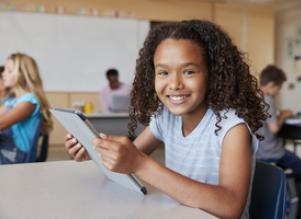12/8/2019
Making Social-Emotional Learning Part of Everyday School Instruction
Getting students to read and write well is a key goal of language arts instruction. But what if teachers paired reading and writing with social-emotional learning (SEL)?
Doing so would grant students access to a range of academic and life skills, according to Margaret Wilson of the International Literacy Association (ILA), who cited a 2019 report from the Washington, D.C.-based nonprofit Aspen Institute in a post on the ILA website.
To compile the From a Nation at Risk to a Nation at Hope report, members of the Aspen Institute National Commission on Social, Emotional, and Academic Development conducted interviews with parents, teachers, students, scientists, and other experts in an effort to expand on what it means to provide young people with a well-rounded education. Indeed, the report's title is a callback to the Reagan era, when the Nation at Risk report—which sounded the alarm about a perceived decline in school quality in the United States—led to an ongoing emphasis on a back-to-basics approach, with schools being asked to impart core academic skills first and foremost.
But according to the Aspen Institute report, those core academic skills are simply not enough, as “to reach a child’s mind, we must be concerned for the whole person.” Enter social-emotional learning.
The 411 on SEL
First, let’s take a look at what SEL is all about, using the National Mentor Resource Center as a guide. According to the center, SEL:
-
Is relationship-based
-
Emphasizes personal traits, such as self-control and perseverance
-
Centers on problem-solving and communication skills
-
Has been “linked to academic, career, and life successes”
-
Often involves goal-setting as a lesson in self-awareness
Highlighting a recommendation in the ILA report that suggests teachers “integrate SEL throughout the school day” to prevent it from simply becoming another add-on to their workload, Wilson contended that the language arts classroom is the perfect place to practice this integration, as well-designed language arts lessons are “centered on engaging topics and rich reading material [that] allow students to connect on a deep and substantive level, enabling them to better understand each other and academic content.”
Indeed, deeper interpersonal connections may compel students to invest more of themselves into lessons, which could in turn make assignments feel more meaningful. As Wilson explained, this can be reinforced through instructional practices that help students “develop empathy, communication, and collaboration skills while improving literacy skills.”
Next, we'll consider what that might look like in practice.

Another ILA post, this one by Marilyn Moore, advised teachers to stock their classroom libraries with books that foster SEL. Moore went on to provide a list of age-appropriate titles aligned to five key SEL attributes: self-awareness, self-control, social awareness, relationship skills, and problem-solving. According to Moore, students can read books that “feature characters who must make complex decisions about conflicting principles and loyalties”—such as Khaled Hosseini's A Thousand Splendid Suns—to both strengthen their reading comprehension skills and gain greater insight into human behavior.
Emphasize SEL content
To round out the curriculum, teachers might consider drawing upon articles and other literacy-related materials that offer SEL lessons. For instance, an EdSurge guide to incorporating SEL in schools highlighted a recommendation by SEL expert Christina Pirzada that teachers actively demonstrate resilience to students, as being able to persevere through challenges and setbacks is a documented aspect of the growth mindset, long-term academic success, and, ultimately, success in life. For educators unsure where to start, Pirzada included a helpful SEL reading list.
Utilize SEL instructional strategies
In a post on the Association for Supervision and Curriculum Development website, middle-school language arts teacher Dr. Stephanie Knight outlined four key classroom strategies for building SEL skills. According to Dr. Knight, it is important for teachers to join their students in self-reflection along with their students—for instance, by pausing before class begins to gather their thoughts and write down their expectations for the lesson—as it can be valuable for students to see that “being more self-aware allows one to make corrections to improve and grow from weak areas.”
Dr. Knight went on to present further ideas about how teachers can embed SEL into everyday, literacy-based instructional practices. For instance, helping students learn how to work together can teach powerful lessons about self-awareness, collaboration and problem-solving, while also fostering deeper engagement with course materials.
In the end, these strategies lead back to the same goal: facilitating student access to a well-rounded, comprehensive education. Teachers who may feel overwhelmed by such a prospect should keep the following in mind, as articulated by Margaret Wilson of the ILA: “Everything you do to help students learn to talk directly to each other, respectfully respond to each other, and build on each other’s comments will pay off for them academically as well as socially.”

